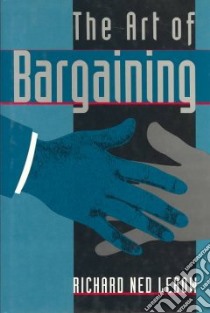The Art of Bargaining - 9780801851988
Un libro in lingua di Lebow Richard Ned edito da Johns Hopkins Univ Pr, 1996
- € 40.70
- Il prezzo è variabile in funzione del cambio della valuta d’origine
Bargaining for what we want or need is a part of our everyday lives. But how often do we stop to consider all the factors that go into the bargaining process? How often do we look at the strategies and tactics available to us? And how often do we hurt our own position by failing to do so?
In The Art of Bargaining, Richard Ned Lebow draws on his years of experience with the United States government, NATO, and numerous European and American businesses to explain the principles of negotiation—from buying a car to planning business mergers to signing an international treaty. Unlike studies that examine only what is said and done at the negotiation table, The Art of Bargaining looks at the context in which negotiation takes place—and shows why some of the most critical decisions about bargaining are made even before the parties sit down to talk.
Lebow begins with a discussion of the nature of bargaining and why people choose to bargain. Because bargaining is a strategy, it is imperative to consider the end goal before deciding on the means for achieving it. Lebow explores the relationship between bargaining and its goals and compares the bargaining process with some other strategies—such as coercion or threats—that can achieve similar goals.
An in-depth study of the decision to negotiate reveals that there are three distinct approaches to the process: coordination (mutual accommodation of both parties' interests); punishment (the use of threats to influence agreement); and reward (making agreements seem more attractive through incentives). Lebow explains how all three approaches can be used effectively once the context of the negotiation has been properly analyzed.
Using concrete examples of negotiation from everyday life as well as world politics, The Art of Bargaining provides the reader with ways to increase bargaining leverage, analyze the strategies and goals of bargaining opponents, and overcome the obstacles that present themselves at the negotiation table.
Informazioni bibliografiche
- Titolo del Libro in lingua: The Art of Bargaining
- Lingua: English
- Autore: Lebow Richard Ned
- Editore: Johns Hopkins Univ Pr
- Collana: Johns Hopkins Univ Pr (Hardcover)
- Data di Pubblicazione: 01 Marzo '96
- Genere: POLITICAL SCIENCE
- Argomento: Negotiation
- Pagine: 193
- Dimensioni mm: 234 x 158 x 19
- EAN-13: 9780801851988


